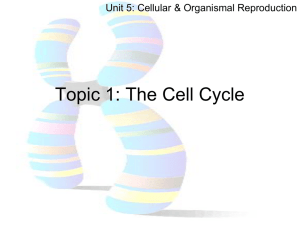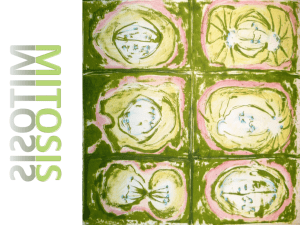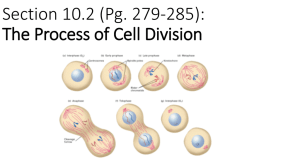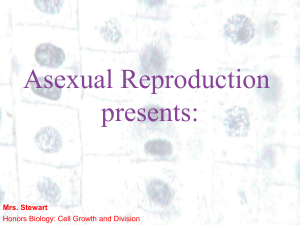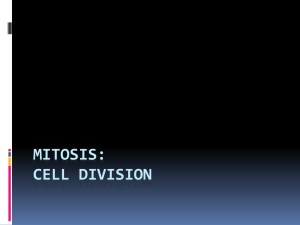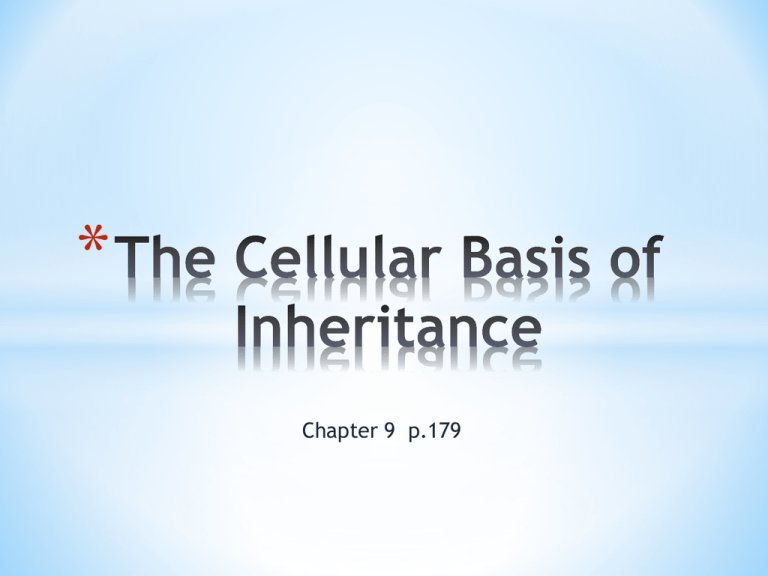
*
Chapter 9 p.179
*
Objectives
1.Describe how cell reproduction contributes to repair and to
growth.
2.Contrast the two main ways that organisms reproduce.
Key Terms
asexual reproduction
sexual reproduction
2
*
-The skin on your arm.
Figure 9-1
Cell reproduction enables your body to produce new skin cells
that replace dead cells at your skin's surface.
3
*
-Asexual reproduction: process in which a single cell or set of cells
produces offspring that inherit all their genetic material from one
parent
-e.g Paramecium, geranium
4
*
-Sexual reproduction: process in which genetic material from two
parents combines and produces offspring that differ genetically
from either parent.
-e.g Birds, human.
5
Concept Check 9.1
1. Relate cell reproduction to the replacement of skin cells.
2. Describe two ways in which asexual and sexual reproduction differ.
3. How is cell division involved in growth?
6
*
Objectives
1.
2.
Describe the structure of a chromosome.
Name the stages of the cell cycle and explain what happens
during each stage.
Key Terms
* chromatin chromosome sister chromatid centromere cell
cycle interphase mitotic phase mitosis cytokinesis
7
*
-200 trillion cells.
chromatin
chromosome
sister chromatid
centromere
Figure 9-4
Each chromosome in a reproducing cell undergoes the duplication
and separation process shown here. Duplication occurs during
8
interphase, in preparation for cell division.
*
-Interphase
Figure 9-5
In humans and other mammals, cells that reproduce daily have a cell cycle that usually lasts 10
to 20 hours. The S phase takes about 3 to 6 hours, while the G 2 phase is slightly shorter.
9
*
-Mitotic Phase
mitosis
cytokinesis
Figure 9-6
This diagram of the cell cycle, showing only one chromosome, highlights the mitotic phase (M).
The duplicated chromosomes are separated during mitosis and distributed into daughter cells
that form through cytokinesis. (The term "daughter" refers to offspring cells and does not imply
female gender.)
10
Concept Check 9.2
1. Describe how the appearance of chromosomes changes as a cell is about to
divide.
2. Interphase used to be described as a "resting phase." Why is this description
inaccurate?
3. Summarize the events that occur during mitosis and cytokinesis.
11
*
Which of the following is a correct statement about the events of the cell cycle?
a.
b.
c.
d.
Little happens during the G1 and G2 phases.
DNA replicates during cytokinesis.
The M phase is usually the longest phase.
Interphase consists of the G1, S, and, G2 phases.
12
*
Objectives
1.
2.
Summarize the major events that occur during each phase of
mitosis.
Explain how cytokinesis differs in plant and animal cells.
Key Terms
* spindle centrosome prophase metaphase anaphase
telophase cell plate
13
*
Spindle:
Centrosomes:
Centrioles:
Figure 9-8
Mitosis begins after the chromosomes have duplicated in
interphase and ends when telophase is completed.
14
*
Figure 9-8
Mitosis begins after the chromosomes have duplicated in
interphase and ends when telophase is completed.
15
Interphase:
*
Prophase :
Metaphase:
Anaphase:
Telophase:
and
Cytokenesis:
Figure 9-8
Mitosis begins after the chromosomes
have duplicated in interphase and ends
when telophase is completed.
16
*
cell plate:
Figure 9-9
In a dividing plant cell the growing cell plate eventually fuses with the plasma membrane of the
parent cell, and the cell wall material joins the existing cell wall. Two daughter cells result, each
with its own plasma membrane and cell wall.
17
Concept Check 9.3
1. Describe a significant event that occurs in each of the four stages of mitosis.
2. Compare and contrast cytokinesis in animal and plant cells.
3. In what sense may prophase and telophase in mitosis be characterized as
opposites?
18
Copyright Pearson Prentice Hall
Mitosis Overview
http://www.5min.com/Video/Learn-about-the-Mitosis-Cell-Cycle-117557481
http://www.youtube.com/watch?v=Q6ucKWIIFmg&feature=related
Copyright Pearson Prentice Hall
*
Objectives
1.
2.
Compare benign and malignant tumors.
Explain how cancer treatments can work at the cellular level.
Key Terms
* benign tumor
* malignant tumor
* cancer
* metastasis
21
*
what is cancer?
benign tumor: mass of normal cells that remain at their original
site
malignant tumor: mass of abnormal cells resulting from
uncontrolled cancer cell division
cancer: disease caused by severe disruption of the mechanisms
that normally control the cell cycle
metastasis: spread of cancer cells beyond their original site in
the body
22
*
Figure 9-11
Cells in a cancerous tumor reproduce at an abnormally fast rate and become irregular in
appearance. When individual cells metastasize (travel from the original tumor), the cancer can
spread.
23
*
24
Concept Check 9.4
1. List two differences between benign tumors and malignant tumors.
2. How might drugs that interfere with mitosis be effective in treating cancer?
3. How is cancer related to cell reproduction?
25
Meiosis functions in sexual
reproduction (9.5)
Objectives
1. Describe how homologous chromosomes are alike and how they differ.
2. Contrast haploid and diploid cells.
3. Summarize the process of meiosis.
Key Terms
*
meiosis karyotype homologous chromosome sex chromosome
diploid gamete haploid fertilization zygote tetrad
26
Homologous Chromosomes
Meiosis: type of cell division that
produces four cells, each with half
as many chromosomes as the
parent cell
Karyotype: display of a person's 46
chromosomes
Homologous chromosome: one of
a matching pair of chromosomes,
one inherited from each parent
Figure 9-13
Karyotype displays are made when
chromosomes are visible during metaphase;
therefore, each chromosome actually consists
of two chromatids. In a true karyotype you
would not be able to distinguish the sister
chromatids. This illustration, however, shows
how a homologous pair would look if you could
distinguish the sister chromatids on each
27
chromosome.
Homologous Chromosomes
Meiosis: type of cell division that
produces four cells, each with half
as many chromosomes as the
parent cell
Karyotype: display of a person's 46
chromosomes
Homologous chromosome: one of
a matching pair of chromosomes,
one inherited from each parent
Sex chromosome: one of two
chromosomes of the 23rd pair of
human chromosomes, which
determine an individual's gender
Figure 9-13
Karyotype displays are made when
chromosomes are visible during metaphase;
therefore, each chromosome actually consists
of two chromatids. In a true karyotype you
would not be able to distinguish the sister
chromatids. This illustration, however, shows
how a homologous pair would look if you could
distinguish the sister chromatids on each
28
chromosome.


